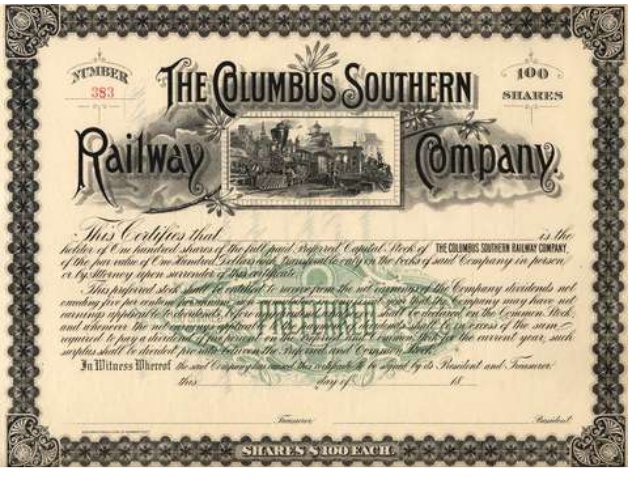The world’s first shares date back to Ancient Rome
Although it was in northern Europe at the beginning of the 17th Century that joint ownership of companies first became popular. The world’s first joint stock company, the Dutch East India Company, was formed in 1602 by the merger of several small Dutch traders.
The Dutch East India Company was given the exclusive right by the Dutch government to import spices from the ‘spice islands’ – now part of Indonesia – but shipping was an expensive and high risk activity which required considerable investment.
Over 50% of all voyages ended in shipwreck, and the price of spices was very volatile, so in order to raise finance risks needed to be spread as widely as possible. Until 1602, each venture by Dutch and Portuguese traders was funded separately, and wound-up (liquidated) after each voyage, once the financiers received their profit. However, the formation of the Dutch East India Company as a long term trading venture meant that company shares had to be issued rather than just shares for each voyage.
Stock exchanges
The world’s first stock exchange was also set up by the Dutch East India Company in 1602. This enabled the company to become the world’s largest and the first recognisable multinational company.
Any Dutch citizen could buy shares in this company, and crucially they could be traded. In 1606, the first paper share was issued, and the word shareholder came into common use.
The formation of joint stock companies, and the trading of shares, rapidly became popular across Europe. By 1698, shares were being traded in the coffee houses of London, the forerunner the London Stock Exchange.
At this point, other countries began creating similar companies, and buying shares of stock was all the rage for investors. The excitement blinded most investors and they bought into any company that began available without investigating the organization. This resulted in financial instability, and eventually in 1720, investors became fearful and tried to sell all their shares in a hurry. No one was buying however, so the market crashed.
Another financial scandal followed in England shortly after— the South Sea Bubble. But even though the idea of a market crash concerned investors, they became accustomed to the idea of trading stocks.
Although the first stock market began in Amsterdam in 1611, America didn’t get into the stock market game until the late 1700s. It was then that a small group of merchants made the Buttonwood Tree Agreement. This group of men met daily to buy and sell stocks and bonds, which became the origin of what we know today as the New York Stock Exchange (NYSE).
A
lthough the Buttonwood traders are considered the inventors of the largest stock exchange in America, the Philadelphia Stock Exchange was America’s first stock exchange. Founded in 1790, the Philadelphia Stock Exchange had a profound impact on the city’s place in the global economy, including helping spur the development of the U.S.’s financial sectors and its expansion west.
In 1971, trading began on another stock exchange in America, the National Association of Securities Dealers Automated Quotations or otherwise known as the NASDAQ. In 1992, it joined forces with the International Stock Exchange based in London. This linkage became the first intercontinental securities market.
Unlike the NYSE, a physical stock exchange, the Nasdaq allowed investors to buy and sell stocks on a network of computers, as opposed to in-person trading. In addition to the NYSE and the NASDAQ, investors were able to buy and sell stocks on the American Stock Exchange or other regional exchanges such as the ones in Boston, Philadelphia, and San Francisco.
Here is a timeline of major events in the stock market’s history:
• Late 1400s: Antwerp, or modern day Belgium, becomes the center of international trade. Merchants buy goods anticipating that prices will rise in order to net them a profit. Some bond trading also occurs.
• 1611: The first modern stock trading is created in Amsterdam. The Dutch East India Company is the first publicly traded company, and for many years, it is the only company with trading activity on the exchange.
• Late 1700s: A small group of merchants made the Buttonwood Tree Agreement. The men meet daily to buy and sell stocks and bonds, a practice that eventually comes to form the New York Stock Exchange.
• 1790: The Philadelphia Stock Exchange is formed, helping spur the development of the U.S.’s financial sectors and the country’s expansion west.
• 1896: The Dow Jones Industrial Average is created. It initially has 12 components that were mainly industrial companies.
• 1923: The early version of the S&P 500 is created by Henry Barnum Poor’s company, Poor’s Publishing. It begins by tracking 90 stocks in 1926.
• 1929: The U.S. stock market crashes after the decade-long “Roaring 20s,” when speculators made leveraged bets on the stock market, inflating prices.
• 1941: Standard & Poor’s is founded when Poor’s Publishing merges with Standard Statistics.
• 1971: Trading begins on another U.S. stock exchange, the National Association of Securities Dealers Automated Quotations, otherwise known as the NASDAQ.
• 1987: Corporate buyouts and portfolio insurance helped prices in the market run up until Oct. 19, what becomes known as “Black Monday.”
• 2008: The stock market crashes after the boom and bust of the housing market, along with the proliferation of mortgage-backed securities in the financial sector.


Great story, some light reading between all the heavier stuff. Everything is usefull but not everything is as important. Thank you so much. Untill next time,
P.P.